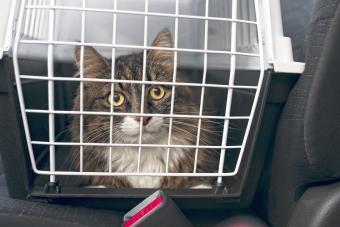
If you reside in an area where hurricanes are a concern, you likely have an emergency plan for your family, but are your small pets included? Owners must understand the steps necessary for pet hurricane preparedness. From what to include in an emergency preparedness kit to the best ways to transport each species should you need to evacuate, this guide can help you prepare for the worst.
Prepare for Hurricane Season
Disaster can strike at any time, so you must be prepared to protect not only yourself, but also your feathered, furred, or scaled friends. Ines de Pablo, emergency preparedness expert and founder of Wag'N Pet Emergency Management, reminds owners, "First and foremost, you are your pet's 911!" She recommends pet owners use a "five-step process: Accept. Plan. Rehearse. Adapt. Rehearse again."
"Planning for the worst and hoping for the best is my recommended approach," de Pablo states. "After you accept that something can happen to you, and after you start thinking of a plan, rehearse the plan. A non-rehearsed plan is a terrible plan. Once you practice, you will find weaknesses, and will have to adjust/tweak a few things. Then rehearse again. The only constant in life is change." This means having a well-rehearsed plan of action to safely evacuate your pet as well as a disaster kit of pet supplies.
Small Pet Disaster Supply Kit
De Pablo advises that owners should pack an emergency supply kit with enough resources for a minimum of 72 hours, though it's "better to plan for a week," she states. Use this list as a guideline to pack a dedicated emergency kit for your small pet, and adjust the contents based on their species. Have these items neatly packed in a bag, box, or portable container so you can grab it and go.

- Pet carrier, cage, or tank
- Water (1-week supply)
- Food (1-week supply)
- Supplements (1-week supply)
- Any medications your pet takes
- Tongs for feeding (reptiles and amphibians)
- Hay (rabbits, guinea pigs, and other rodents)
- Exercise pen
- Food dishes
- Water dish or bottle
- Litter pan and litter (for litter-trained rabbits and ferrets)
- Bedding or substrate
- Lighting (reptiles and amphibians)
- Heat source (reptiles and amphibians)
- Thermometer and hygrometer (reptiles and amphibians)
- Portable generator (for reptile and amphibian cages)
- Power strip and extension cord
- Cleaning supplies
- Trash bags
- First aid kit
- Toys or hides
- Photos of your pet
- Printed copy of medical records
Identification for All Species
Unfortunately, there's always a possibility that your small pet could become lost in the chaos of the disaster. Proper identification will help increase your chances of being successfully reunited. Most pets, including dogs, cats, rabbits, ferrets, rats, larger birds, and reptiles, can have microchips placed under their skin. Small mammals and larger lizards can wear collars with a small tag, and leg ID bands may work for birds. These external methods of identification are important to have and put on your pet before transporting them.
Safely Transport Your Small Pet
Should the need arise to leave your home, there are a variety of transporting options based on the type of small pet.
Birds
In the case of an evacuation, you can use a collapsible bird cage or crate. Cardboard carriers are another option de Pablo mentions, although these are less favorable for birds. Regardless of what you use, she says, "Write your name and address (regular and evacuation site) on the carrier using an indelible marker, or on a tag attached to the carrier or cage." In order to keep your bird calm during transit, she recommends keeping the cage dark. "This can be accomplished by throwing a towel over the cage," de Pablo suggests.
Reptiles
The method by which you move your reptile largely depends on the species and their size. De Pablo advises, "Snakes should first be wrapped in a cloth sack. If you've got a plain old garden snake, a pillowcase will do. That sack should then be tied off and placed inside a sturdy container that's easy to open and close with ventilation holes small enough to prevent the critter from escaping. There also must be enough room inside for the snake to lie down naturally."
You can use this method for large lizards as well. Always be sure to label the box with the phrase "LIVE ANIMAL" to alert people to the contents. "Venomous snakes get a special tag that includes the reptile's scientific name and a pictorial warning label," de Pablo reports.
Fish
Moving pet fish may sound impossible, but it can be done. De Pablo advises aquatic owners, "If you must take your fish, a Styrofoam cooler lined with a heavy black garbage bag works well to hold your fish for transport." However, some tanks are too large or complex to move. In those cases, you may be forced to leave your fish, in which case you should prepare for an alternate source of power to keep the heater and filter working.
De Pablo states, "If you elect to leave the fish behind, make sure to hook up the tank to an outdoor generator, which is not the best plan as I can see it flying away or being stolen. Another option is to go to PetSmart and pick up a battery powered air pump and a battery operated feeder that holds enough food for at least two weeks."
Small Mammals
Small mammals like rabbits, ferrets, chinchillas, gerbils, rats, and other rodents can be transported in much the same way as a cat. Getting your pet accustomed to a travel carrier or crate before a disaster is essential. "Always make sure your pet gets used to the transport crate and the car motion by taking them on rides occasionally," de Pablo recommends. If the crate is a familiar and safe place for your pet, they'll feel much more calm should you have to evacuate.

Know Correct Pet Hurricane Preparedness
Although these plans are directed toward pet hurricane preparedness, they can be applied to any natural disaster. Ines cautions, "Every one of your readers is at risk for a residential fire or gas leak at a very minimum. What's your 2 a.m. plan for a house fire?" Keep your pet safe with a pet disaster kit and a detailed plan.







